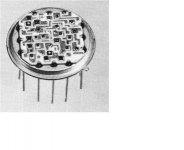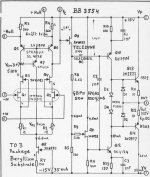Here are some slides from a talk I gave this week.
The fifth is a plot of input voltage vs distortion for a bunch of small amplifiers. NOTE that some of the amplifiers do not have the distortion continue to fall until clipping begins. These are noise limited amplifiers.
So what was the point of these slides?
Don't know, but isn't the fifth THD plus noise? I don't like the last even though it is very popular.
Don't know, but isn't the fifth THD plus noise? I don't like the last even though it is very popular.
The result is THD + Noise, the plotting method is to sum everything other than the signal which gives that result. However the common shorthand is to call it a THD plot.
Hint, when you actually listen to an amplifier what is the actual output level?
A hybrid is a device which is made using individual silicon chips, resistors, capacitors, and the occasional inductor epoxied or soldered to an alumina, beryllia, aluminum nitride, or sapphire substrate to create on a very small scale what we would do with a circuit board. It allowed chips of different technologies such as high voltage powerfets, low voltage low noise ic's, large and small value resistors, scr's, led's, whatever... to be used in a very small package. The linked device may have ten or 20 seperate components within.
jn
Thanks jn for that (I'm glad I noticed you answered already).
BTW, the schematic for the 3554 on the Burr-Brown datasheet I linked to appears to be at variance with the specifications, which suggest it has JFETs in the front end (the amount of bias current and its temperature dependence is a giveaway).
Brad Wood
A hybrid is a device which is made using individual silicon chips, resistors, capacitors, and the occasional inductor epoxied or soldered to an alumina, beryllia, aluminum nitride, or sapphire substrate to create on a very small scale what we would do with a circuit board. It allowed chips of different technologies such as high voltage powerfets, low voltage low noise ic's, large and small value resistors, scr's, led's, whatever... to be used in a very small package. The linked device may have ten or 20 seperate components within.
Thanks for the explanation. At least I know what to look into when I need to find further information. Coz it is hard for me to differentiate between "chip" and "chip plus". It shouldn't be just about size, but should be about different technology that make chips a different creature than discrete. It reminds me of STK "chips" (so that's why old STK documentation used the "hybrid" and "module" terminology in the datasheet).
From the looks of the schematic I saw yesterday and mysteriously appears to be inaccessible today, the drafting person lacked a symbol for JFETs and substituted bipolars. If the four input bipolars are changed to JFETs everything else looks pretty straightforward, indeed pretty boring.I have the schematics of BB3554, but I think it was provided by Scott, if he agrees, I can post it.
Of course the part has been long discontinued.
"Raja of Invincible America" sounds like a candidate for Avatar.
jneutron, you have to know this guy he was/is? in your biz right yes/no?
He is a theorist.
Not an experimentalist.
I don't mingle with the theorists.
A theorist is someone who looks at hardware and says. WHA??
An experimentalist is someone who breaks the hardware and says...WHA?
jn
Of course the arch theoretician Pauli was known to cause hardware to break merely by being in the vicinity.He is a theorist.
Not an experimentalist.
I don't mingle with the theorists.
A theorist is someone who looks at hardware and says. WHA??
An experimentalist is someone who breaks the hardware and says...WHA?
jn
I have the schematics of BB3554, but I think it was provided by Scott, if he agrees, I can post it.
No problem, there was a thread 2 or 3 years age when I posted many already. That schematic was reversed engineered here so it is correct.
Example of hybrid (not 3554)
Attachments
Last edited:
I notice that things have gotten quiet, lately. '-) I presume that ending speculation tends to do that.
I am very surprised that many here did not jump on the idea of making a simple dual IC line amp, and directly comparing it with anything else available or perhaps possible.
I am constantly confronted by my critics that this is 'reality' and that my 'extreme' efforts are just a waste of time, but I haven't gotten any takers as of yet.
Of course, anybody can take just about any line amp and compare it to another line amp and get a NULL result. Unfortunately, I must insist on an 'open' test, at least a defined A or B, is necessary to hear any difference. Still, A and B could be randomly selected, even by computer, it is just knowing that A is always A, and B is always B when making the comparison, that is important to me.
I think that people should put their efforts into what they believe, rather than putting down the beliefs of others. Then, relatively neutral third parties can decide if one is better than another, to eliminate self bias. This is how we do it in the audio industry, at least 'ideally'.
I am very surprised that many here did not jump on the idea of making a simple dual IC line amp, and directly comparing it with anything else available or perhaps possible.
I am constantly confronted by my critics that this is 'reality' and that my 'extreme' efforts are just a waste of time, but I haven't gotten any takers as of yet.
Of course, anybody can take just about any line amp and compare it to another line amp and get a NULL result. Unfortunately, I must insist on an 'open' test, at least a defined A or B, is necessary to hear any difference. Still, A and B could be randomly selected, even by computer, it is just knowing that A is always A, and B is always B when making the comparison, that is important to me.
I think that people should put their efforts into what they believe, rather than putting down the beliefs of others. Then, relatively neutral third parties can decide if one is better than another, to eliminate self bias. This is how we do it in the audio industry, at least 'ideally'.
John, as i said, i compare my preamps with a strait wire. it would be a nonsense to compare blue and green. Really, i do not need any blind procedure, i'm looking for trouble, not for pride. Of course this is possible when no added hiss, but i'm dedicated with digital. I'm not listening for *sound quality*, I'im listening to differences. If any, i try something else. As is said, i'm not able to hear noticeable difference between my preamp and a wire, why i should look for something else ?
Does-it make sens to you ?
BTW, i never read "reviews", and i'm very suspicious (as you had noticed) about my own *opinions*, and *opinions* of others as well. But when, after many experiences, always correlated, i found something who can make myself a rule, i share-it.
[edit] When comparing to differences, there is, sometimes subtle ones, you need to compare and compare again... When it is so, i do not insist, and consider-it as a no-difference.
Does-it make sens to you ?
BTW, i never read "reviews", and i'm very suspicious (as you had noticed) about my own *opinions*, and *opinions* of others as well. But when, after many experiences, always correlated, i found something who can make myself a rule, i share-it.
[edit] When comparing to differences, there is, sometimes subtle ones, you need to compare and compare again... When it is so, i do not insist, and consider-it as a no-difference.
Last edited:
John,
As one of the neutral figures here I follow what you are saying. At the same time it would appear that the discrete designer should have some real advantage as you can select every single individual component and also make any minor circuit corrections that you may choose to implement While the IC component direction would have the advantage of physical size of a circuit and perhaps more current investment in R&D, it appears that not much of any of that would be directed at the audio industry per say. A/D and D/A converters perhaps being the exception. I would imagine that a fair minded designer would probably use a combination of both approaches to achieve their ultimate designs.
As one of the neutral figures here I follow what you are saying. At the same time it would appear that the discrete designer should have some real advantage as you can select every single individual component and also make any minor circuit corrections that you may choose to implement While the IC component direction would have the advantage of physical size of a circuit and perhaps more current investment in R&D, it appears that not much of any of that would be directed at the audio industry per say. A/D and D/A converters perhaps being the exception. I would imagine that a fair minded designer would probably use a combination of both approaches to achieve their ultimate designs.
Not so sure: We had tried this joke near a well known reviewer, during the listening session with some real other preamps.A wire will usually win in my world! '-)
The wire was not the winner, according to his notes
We were not in so good relationship with him, after having revealed the trickery
Kindhornman, usually discrete wins, except for digital, at least in the 'subjective' test.
And tubes will often beat solid state. I have come to accept this.
but "have come to accept this" on the bais of 20 yr old op amp comparisons really isn't sufficient when the tech is a moving target - monolithic in particular has really stepped up in process and design in the past decade or so - but when you mention IC's you only talk much older parts
No problem, there was a thread 2 or 3 years age when I posted many already. That schematic was reversed engineered here so it is correct.
OK.
Attachments
- Status
- Not open for further replies.
- Home
- Member Areas
- The Lounge
- John Curl's Blowtorch preamplifier part II

